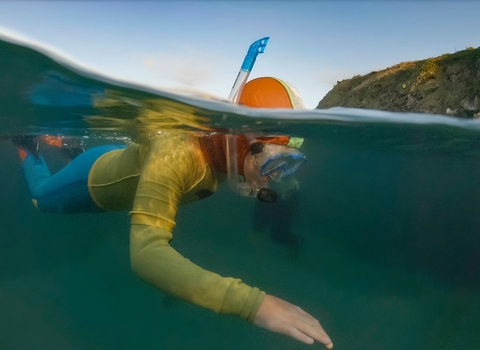Seagrass meadow on the Helford river, Image by Cornwall Wildlife Trust's Matt Slater
Restoring Cornwall's Seagrass
What is seagrass?
Seagrass is the only flowering plant that can live in seawater. It often grows in large groups giving the appearance of terrestrial grassland – an underwater meadow. These meadows can be found in shallow coastal areas on sheltered sandy or muddy seabeds and can be exposed at low tide.
Why is seagrass so important?
Seagrass is vital for the health of our oceans and the wider planet. These underwater meadows support a diverse ecosystem, acting as a nursey site for fish, providing food and shelter for tiny invertebrates, marine mammals and waterfowl and protecting our shorelines from coastal erosion.
Seagrasses also have the potential to store huge amounts of carbon and because of this are known as a natural solution to fighting climate change. Despite covering less than 1% of the ocean floor, seagrass beds are responsible for 15% of its total carbon capture.
In the UK, we have lost up to 90% of our seagrass meadows in the last 100 years. There are many factors that have led to the decline of seagrass: from physical pressures such as dredging and the use of mobile fishing gear; to pollution and even the increase of non-native species that outcompete our native seagrass. Seagrass meadows were also severely affected by a disease in the 1930s.
Did you know we have seagrass in Cornwall?
Although seagrass has suffered severe declines in the UK, we still have vital patches of it here in Cornwall, including off St Austell, Falmouth, Mounts Bay and Looe.
There are two species of seagrass found in Cornwall, otherwise known as eelgrass species. The first, common seagrass (Zostera marina), has leaves up to 1m longer and is typically found on the lower shore. In contrast, dwarf seagrass (Nanozostera noltei) is shorter and thinner than common seagrass (with leaves up to 20cm long) and is found high up the shore in creeks and estuaries.
There are now only a few areas in the South West where dwarf seagrass remains in good condition. One of these places is Cornwall Wildlife Trust’s Fal Ruan nature reserve – the location of the Trust and Seasalt Cornwall’s new seagrass restoration project (see below).
What is the Seeding Change Together project?
Seeding Change Together is a partnership between Cornwall Wildlife Trust and Seasalt Cornwall, launched in 2022 to study and restore intertidal seagrass meadows along Cornwall's coast.
Initially focussing on Cornwall Wildlife Trust's Fal-Ruan nature reserve, where there is an existing Dwarf seagrass meadow, the project has now expanded to sites across Torpoint, Fowey, and the Helford Estuary. This has been made possible with Seasalt Cornwall's continued support along with additional funding from successful grant applications with the Environment Agency (ReMeMaRe), Sea Changers, and Rewilding Britain.
Working closely with volunteers, local communities, and partner organisations, the team is combining science and community action to bring these vital habitats back.
Volunteers are involved in all stages of the restoration process, including collection seeds from healthy donor meadows, sorting and storing the seeds, and then carefully planting them back into estuaries where they have been lost. Each year, hundreds of volunteer hours go into this process, helping to "seed change together" across Cornwall's coastlines.
Restoring Cornwall’s Seagrass Meadows: A Seasalt Cornwall & Cornwall Wildlife Trust Partnership | Seeding Change Together
Seeding Change Together – Project Update Autumn 2025
This year we used the thriving seagrass meadows around Torpoint as our donor bed for restoration. With our trusty upcycled bodyboards in hand, we ventured our over the seagrass meadows at low tide to hand-pick seed pods from the plants. However, we also trialled snorkel collecting this year, which was an amazing opportunity to see the meadow whilst they are submerged in water.
Thank you so much to all of our volunteers who us for any seed picking events - we managed to collect around 35,000 seeds!
After being picked, the seeds were stored in a permeable contained in the sea for several weeks, allowing the plant matter to rot away and for the seeds to continue maturing until eventually being released.
At this stage, it is really important that we keep the container clean to allow a continual flow of fresh seawater over the seeds, as well as to regularly agitate the seeds to avoid fungal growth establishing.
Once again, we relied on our dedicated volunteers for this process as they looked after the seeds on a weekly basis from August to November.
Next, we planted the seeds at two new restoration sites, one in the Fowey Estuary, and one in the Helford. After trialling other planting methods in previous years, we decided to use mud injection this year - a fun but messy task! Carefully mixing the seeds with a specific ratio of mud to seed, the seeds were then injected into the ground where they will hopefully sit for the winter and germinate in spring.
Thank you so much again to all our amazing volunteers who have dedicated over 400 hours of their time to collecting, sorting, and planting the seagrass seeds this year. We couldn't have done it without you!
In the video below, hear from Nia, our Seagrass Assistant Officer, with an update on the project.
Cornwall Wildlife Trust hopes this pioneering project could lead the way for large-scale seagrass restoration across Cornwall, with the support from the Your Shore Network. The Trust will liaise with Cornwall Council, harbour authorities and other environmental organisations to make sure this project aligns with wider blue carbon work in Cornwall.
Keep up to date with the project’s progress by following us on social media.
A huge thank you to Seasalt Cornwall for funding this project.




